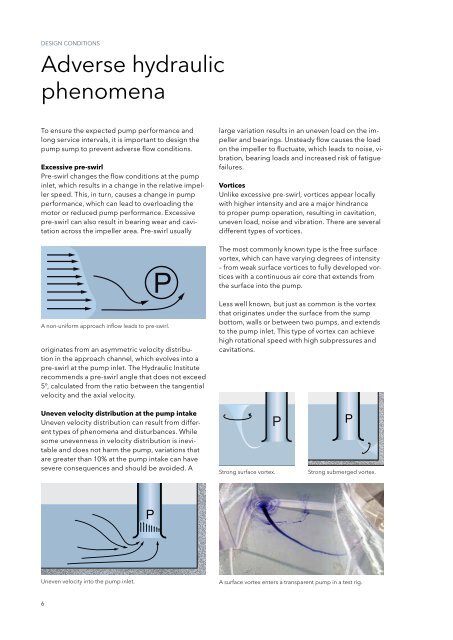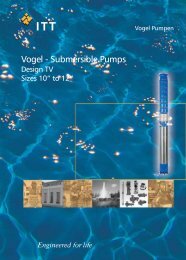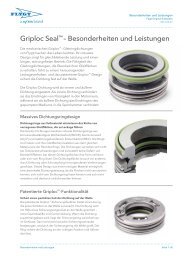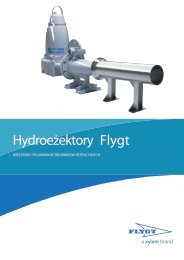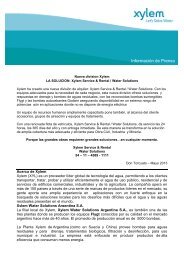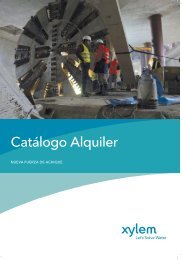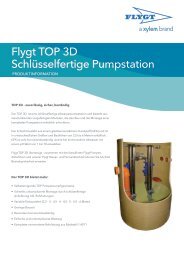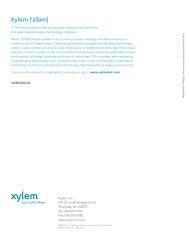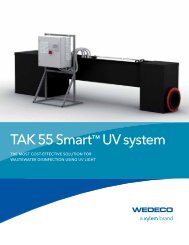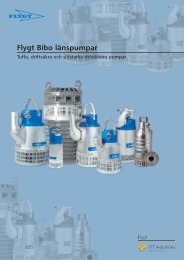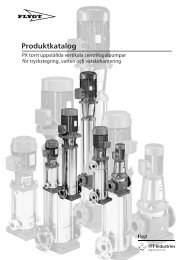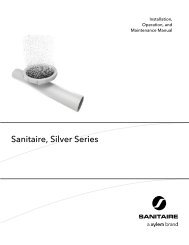Computational fluid dynamics - Flygt
Computational fluid dynamics - Flygt
Computational fluid dynamics - Flygt
Create successful ePaper yourself
Turn your PDF publications into a flip-book with our unique Google optimized e-Paper software.
Design conditions<br />
Adverse hydraulic<br />
phenomena<br />
To ensure the expected pump performance and<br />
long service intervals, it is important to design the<br />
pump sump to prevent adverse flow conditions.<br />
Excessive pre-swirl<br />
Pre-swirl changes the flow conditions at the pump<br />
inlet, which results in a change in the relative impeller<br />
speed. This, in turn, causes a change in pump<br />
performance, which can lead to overloading the<br />
motor or reduced pump performance. Excessive<br />
pre-swirl can also result in bearing wear and cavitation<br />
across the impeller area. Pre-swirl usually<br />
large variation results in an uneven load on the impeller<br />
and bearings. Unsteady flow causes the load<br />
on the impeller to fluctuate, which leads to noise, vibration,<br />
bearing loads and increased risk of fatigue<br />
failures.<br />
Vortices<br />
Unlike excessive pre-swirl, vortices appear locally<br />
with higher intensity and are a major hindrance<br />
to proper pump operation, resulting in cavitation,<br />
uneven load, noise and vibration. There are several<br />
different types of vortices.<br />
The most commonly known type is the free surface<br />
vortex, which can have varying degrees of intensity<br />
– from weak surface vortices to fully developed vortices<br />
with a continuous air core that extends from<br />
the surface into the pump.<br />
A non-uniform approach inflow leads to pre-swirl.<br />
originates from an asymmetric velocity distribution<br />
in the approach channel, which evolves into a<br />
pre-swirl at the pump inlet. The Hydraulic Institute<br />
recommends a pre-swirl angle that does not exceed<br />
5°, calculated from the ratio between the tangential<br />
velocity and the axial velocity.<br />
Less well known, but just as common is the vortex<br />
that originates under the surface from the sump<br />
bottom, walls or between two pumps, and extends<br />
to the pump inlet. This type of vortex can achieve<br />
high rotational speed with high subpressures and<br />
cavitations.<br />
Uneven velocity distribution at the pump intake<br />
Uneven velocity distribution can result from different<br />
types of phenomena and disturbances. While<br />
some unevenness in velocity distribution is inevitable<br />
and does not harm the pump, variations that<br />
are greater than 10% at the pump intake can have<br />
severe consequences and should be avoided. A<br />
Strong surface vortex.<br />
Strong submerged vortex.<br />
Uneven velocity into the pump inlet.<br />
A surface vortex enters a transparent pump in a test rig.<br />
6


